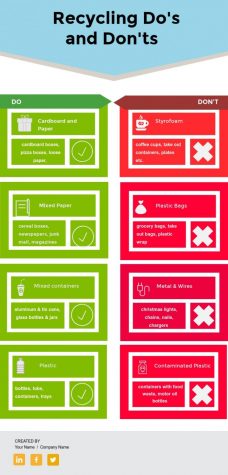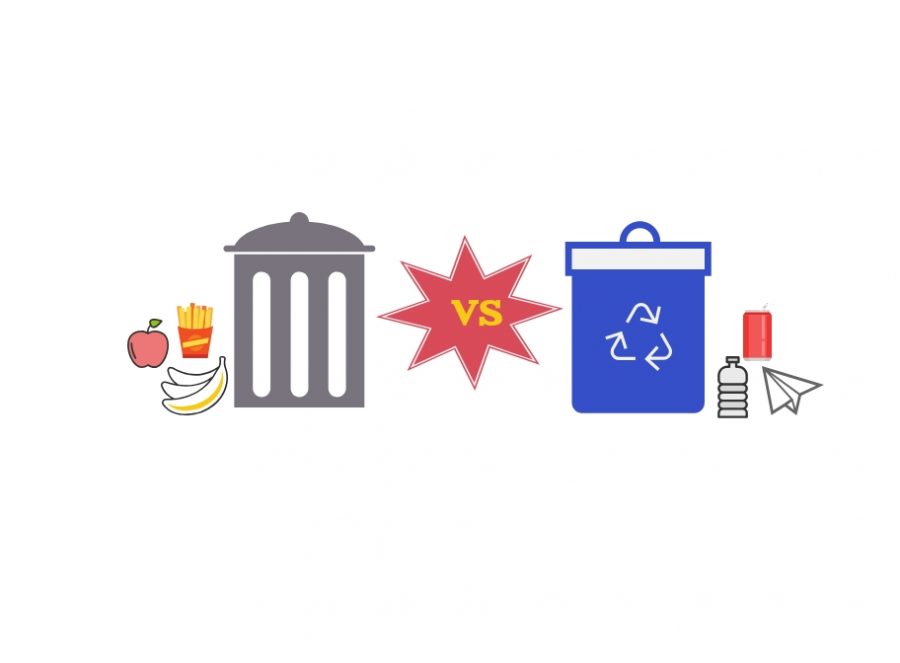The dirty truth about recycling
Paper and plastic nationwide is being dumped in landfills after China’s National Sword policy
April 4, 2019
Picture yourself out for lunch at Central Market; you just finished drinking your coffee. There is a recycling bin across the outdoor patio, or there is a trash can a few feet away: which do you choose? What if you found out that both bins led to the same destructive result?
Thousands of tons of materials left curbside for recycling in American towns and cities are going to landfills. Americans recycle millions of tons of trash per year, trusting that the items that we toss in the blue bin go somewhere other than the landfill. While many hope that their recycling is getting re-purposed or turned into something new, the truth is a lot of it isn’t getting recycled at all. In the past, paper, plastic and other materials were sorted and then shipped abroad to China, where they would be processed. Over a third of the recyclables around the world get shipped abroad and China is the biggest importer. About 45 percent of the world’s plastic set for recycling has been exported to China since 1992.

In 2018 China passed the National Sword policy, banning plastic waste from being imported for the protection of the environment and people’s health. China announced that it no longer wanted to import “foreign garbage.” While some waste managers who send recyclables to be processed domestically, or who ship to alternate countries continue to be successful, a majority of our country’s recycling supply is going directly to the landfill. We now have to ask the question how can we better negotiate among ourselves, among the world’s diverse peoples and cultures, so that we can resolve this issue and navigate toward a better future?
Many local officials are not telling residents about the decline due to a fear that residents will give up on recycling altogether.
While China has strictly banned 24 different materials, it also has demanded that the accepted materials (cardboard and metal) be only 0.5 percent impure. If you do not rinse the container or glass before recycling it, even a tiny amount of food or other trash can ruin a entire batch of recycling. Many waste companies say that the new contamination standards are impossible to meet, while others are attempting to clean up recycling streams by limiting accepted materials and educating people on what items can be recycled.
Long before China’s recycling wall, plenty of “recyclables” ended up in landfills due to “single stream” recycling. Single-stream recycling is where residents are able to put everything in the same bin. This method is a switch designed to encourage more recycling; however, it results in more stuff that can not be recycled because it becomes “contaminated.” The Austin residential recycling department said that about 30 percent of plastic collected in these “single stream” bins can’t be recycled. Scrap plastic, previously exported to China netted $300 million in 2015, but now is only worth about $7.6 million. Alternate countries have stepped in to accept more plastics but exports are still down by 40 percent. Countries such as Malaysia, Thailand or Vietnam, have picked up some of what China is leaving behind; however, they do not waste management systems as well-developed as China’s.
While China has been widely vilified as the cause of the recycling uproar, industry watchers say that the blame should not be placed solely on China. China has announced public-health concerns, environmental concerns, and an aspiration for independence, as reasons for its policy change. So, who then should be held accountable for this mess? It turns out we are all to blame.
China’s waste-import restrictions have shown the flaws and problems of the American recycling industry and how bad American consumers are at recycling. One of the major reasons that China created these restrictions is due to the United States sending too much contaminated material that is not recyclable. Many Americans are “wishful recyclers.”
When you take recycling to the blue bin, whether it be at home or at your job or school, it is considered curbside recycling. Typically, curbside recycling is taken by a private company to a sorting plant where then the marketable goods are separated out. The goods found are then sold by companies or local governments to overseas processors. These private companies used to get paid by selling off these recyclable materials; now, it is as if they are being paid simply to have someone take it away. These stricter requirements are also an indication that recycling is more likely to be deemed “contaminated” if they contain materials that are not recyclable. This situation can be referred to as wishful recycling, where people set aside various items for recycling just because they hope they are recyclable even when they may not be.
Most plastic bags, coffee cups, dirty takeout containers, Christmas lights and garden hoses are all not recyclable, yet many Americans toss their trash into the recycling bin without a second thought.
By 2030 it is predicted that about 111 million metric tons of plastic waste will be displaced because of China’s new law. This amount is equal to nearly half of all plastic waste imported since 1988. There are expectations that this turn in the recycling industry will continue for months or years, but there is also optimism that the industry will eventually emerge better and stronger. Already, new recycling markets have emerged with the potential to perform the role that China once did. Recently, recycling has flooded into other Asian nations.
In order to resolve this quickly escalating problem, Americans should take a few extra steps before depositing items in the blue bin. Rinse containers, glasses, and cartons before recycling them. This two-minute act can save a whole neighborhood’s worth of recycling from being contaminated and sent to the trash. We must act fast, as the amount of waste we create continues to expand. Check local guidelines to find out what can and what cannot be recycled. Get the peanut butter out of the jar, rise out your smoothie cup and never put plastic bags in the recycling. A sustained way of living is what society needs, and we can built one if we embrace beneficial changes to our everyday lives.




